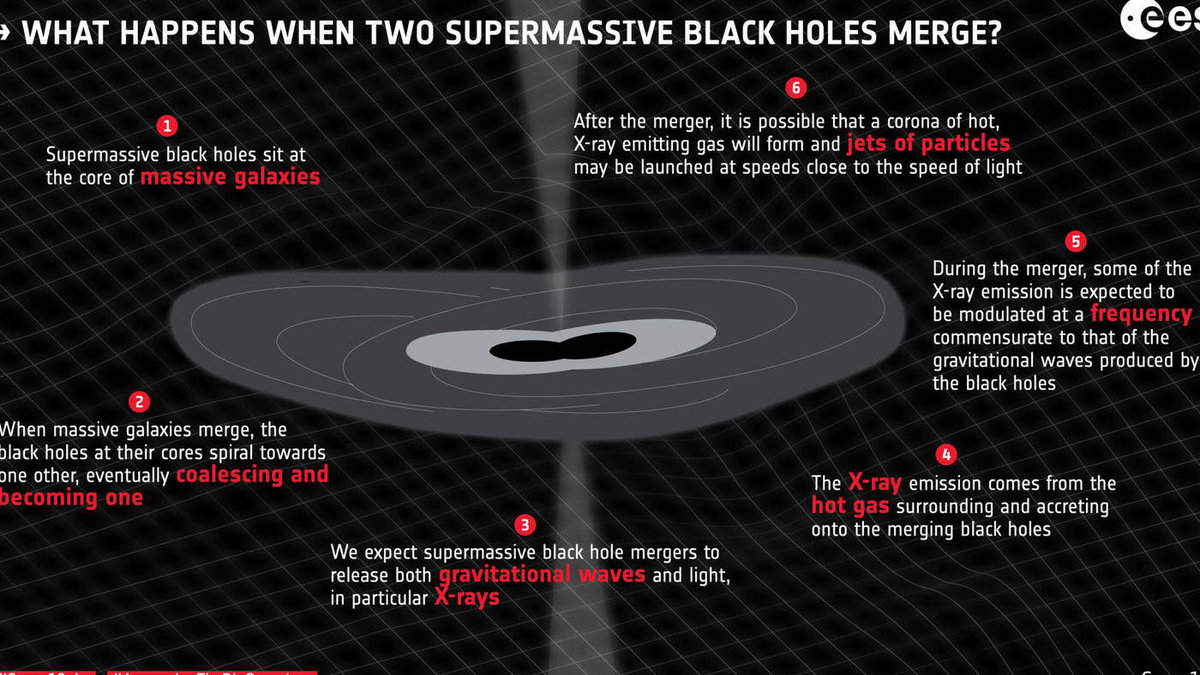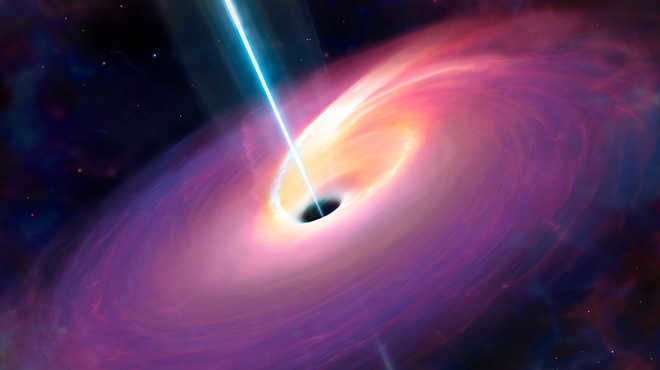
Our current understanding of black holes is still limited, but scientists have been able to make predictions and calculations about their appearance, size, and other physical characteristics thanks to various scientific theories, most notably Albert Einstein’s theory of relativity. While there is little doubt about their existence among the scientific community, black holes are technically considered hypothetical objects.
Nowadays, black holes are regarded as the most peculiar entities in the universe.
During the mid-17th century, knowledge regarding the existence of black holes emerged, and it was later expanded upon by English geologist John Mitchell. Mitchell postulated that stars with the same density as the Sun but 500 times smaller in size would require a first cosmic velocity that exceeds the speed of light.
The first cosmic velocity refers to the minimum speed at which an object must be propelled from a planet’s surface in order to prevent it from falling and instead initiate a circular orbit.
Consequently, it can be inferred that light is unable to escape from the surface of such a star. Thus, it would appear entirely black when observed from the outside.
According to Albert Einstein’s theory of relativity, we gain knowledge that time is influenced by gravity. In other words, the greater the mass of an object in space, the more it decelerates time. Conversely, the gravity of a black hole is so immense that it essentially halts the progression of time.
If you observe a spacecraft descending into a black hole from an external perspective, you will notice that it gradually decelerates and eventually vanishes.
Hence, a black hole is an entity with an infinitely massive mass and density, and consequently, gravity. In contemporary physics, it is believed that the speed of light in a vacuum is the ultimate velocity of material particles. Due to the extreme gravitational pull, not even light can escape from a black hole’s vicinity.
What occurs within the confines of a black hole?
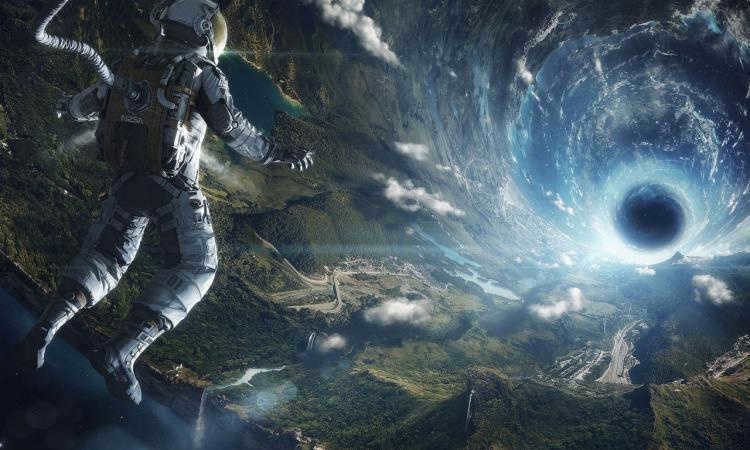
The event horizon is the outer surface of a black hole where the force of the gravitational field and the forces of light trying to escape the black hole reach a balance. Crossing the event horizon is impossible as it traps anything within its boundary.
As you venture deeper into the black hole, you will notice that space becomes increasingly curved until it reaches a point of infinite curvature at the center known as singularity. At this point, the concepts of space and time lose their meaning, rendering the laws of physics ineffective in this extreme environment.
Various viewpoints exist, but the prevailing one is as follows:
Escaping a black hole is theoretically possible, but the experience would be far from pleasant
When entering a black hole, both your body and the surrounding space would undergo extreme warping. This would likely result in your body being stretched to the point of death. However, once you pass through the singularity and into another universe, you would return to your original size.
What occurs when two black holes collide?
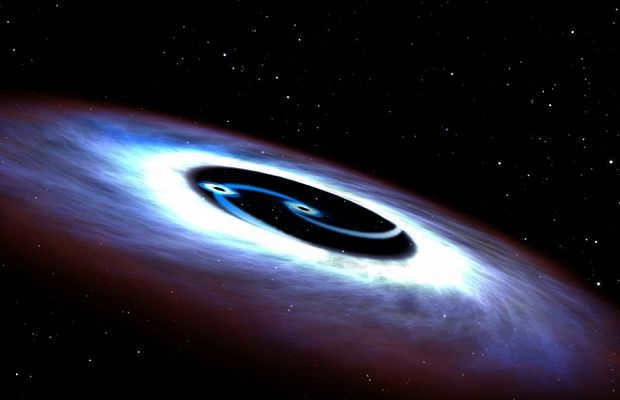
Scientists have never observed collisions between black holes, and the potential sequence of events can only be simulated on a computer.
There are two potential outcomes.
If both black holes are rotating rapidly and collide at the correct angle, the larger black hole will exert enough force to propel the smaller one into space. This scenario is akin to what happens when two bowling balls collide.
The second outcome is more probable. In this scenario, the black holes will slowly move closer to each other until they are consumed by their immense gravitational pull. Eventually, the two black holes will merge into one.
This process is incredibly scary. A black hole formed in this manner is referred to as a binary black hole.. The act of merging two black holes is known as downward ringing.. The emerging black hole gradually becomes symmetrical on all sides and transforms into a perfectly shaped disk that ruthlessly obliterates everything in its path. The collision generates an immense amount of energy. The black hole unleashes powerful pulsating waves of energy that reverberate throughout the entire universe, causing it to literally “shake”.
In summary, if you happen to witness the convergence of two black holes, it would be wise to vacate the area.
In a galaxy located 4.2 billion light-years away from Earth, there are two neighboring black holes emitting wavy jets, while a third black hole slightly further away emits straight jets. This research indicates that such systems are more prevalent than previously believed.
Researchers have made an astonishing revelation: a remote galaxy harbors not just one, but three supermassive black holes in its core. This groundbreaking finding indicates that clusters of these colossal black holes are more prevalent than previously believed, potentially presenting a new method for their detection.
Supermassive black holes, which possess a mass equivalent to millions or even billions of suns, are thought to reside in the core of nearly every large galaxy in existence. While most galaxies contain only one supermassive black hole at their center, galaxies undergo mergers, resulting in the presence of multiple supermassive black holes in some cases.
A group of researchers has recently observed a distant galaxy named SDSS J150243.09+111557.3 and found it to be potentially housing two massive black holes. This galaxy, located approximately 4.2 billion light-years away from our planet, is positioned at a considerable distance within the expanse of the universe, according to the lead author of the study, Roger Deane, who is a radio astronomer affiliated with the University of Cape Town in South Africa. In order to examine this galaxy more closely, scientists employed a method known as ultra-long-baseline radio interferometry (ELBI), which involved combining signals from numerous large radio antennas spread out over distances of up to 10,000 kilometers. The utilization of Europe’s VLBI network allowed the team to capture images with a level of detail 50 times greater than what the Hubble Space Telescope is capable of.
During their investigation, the astronomers made a surprising discovery – the galaxy actually contains not two, but three enormous black holes. Two of these black holes are positioned in such close proximity to each other that they appear as a single unit.
The weight of each of the three black holes is roughly equivalent to that of 100 million suns.
Scientists were previously acquainted with four systems containing three black holes. However, the two objects in the closest pair are separated by a distance of approximately 7,825 light-years. In the new group of supermassive black holes, the smallest gap between them is only about 455 light-years, making it the second closest pair of black holes.
After examining just six galaxies, the researchers stumbled upon this pair of black holes. This discovery suggests that densely populated pairs of supermassive black holes are “much more prevalent than previously thought.” Understanding the frequency at which supermassive black holes merge can provide insights into their impact on galaxies, according to the researchers.
Supermassive black holes have the potential to impact the development of galaxies through the release of energy from turbulent matter consumed by the black hole. Although it has been challenging to distinguish between closely paired supermassive black holes in the past, a recent discovery by researchers indicates that a new pair of black holes leaves behind a distinctive trail of spiral-like radio waves. This discovery suggests that these twisted jets could serve as a recognizable feature of closely paired black holes. If this is indeed the case, high-resolution telescopic observations such as those conducted by the European RSDB network may not be necessary.
Roger Deane, a radio astronomer from the University of Cape Town in South Africa, commented on this finding, stating that the spiral radio jets, which are a characteristic of closely paired black holes, can be an effective means of identifying these systems that are even closer together.
It is believed that closely orbiting black holes produce disturbances in the fabric of spacetime, known as gravitational waves, that can potentially be detected throughout the entire universe. By identifying closer pairs of black holes, scientists will have a more precise estimate of the amount of gravitational radiation these pairs generate, according to Roger Deane, a radio astronomer from the University of Cape Town in South Africa.
The ultimate objective is to achieve a comprehensive understanding of how two distinct black holes from interacting galaxies gradually approach each other, impact their respective galaxies, emit gravitational waves, and eventually merge into a single entity, which is expected to be a momentous and awe-inspiring event.
This is one of the main enigmas in the field of cosmology and stellar evolution. How did the supermassive black holes in the early universe grow to such immense sizes? It is puzzling because they haven’t had enough time to accumulate their mass solely through gradual accretion processes.
An artistic depiction of two newly formed black holes resulting from the death of a single supergiant star.
In order to become supermassive, these black holes had to consume the equivalent of a billion suns. Even with a strong appetite and the force of gravity on their side, this process would take much longer than a few hundred years. And yet, we find these colossal black holes in distant galaxies, already massive when the Universe was just a million years old.
New research conducted at the California Institute of Technology has revealed that the formation of supermassive black holes can be attributed to the demise of specific types of massive stars, which can be likened to ancient stellar dinosaurs that met an early demise. As these colossal stars collapse, not one, but two black holes are born, each accumulating its own mass, before ultimately merging into a singular, gargantuan entity.
In an effort to comprehend the origins of these youthful supermassive black holes, Christian Reisswig, an astrophysics postdoctoral fellow, and Christian Ott, a theoretical astrophysics assistant professor, both from the California Institute of Technology, have developed a model that centers around supermassive stars. These enormous, peculiar stars are believed to have existed only fleetingly during the early stages of the universe.
Unlike typical stars, supermassive stars manage to stabilize themselves in defiance of the forces of gravity, primarily through the emission of their own photons.
Photon emission from a massive star, which is the outward flow of photons caused by the high internal temperatures of the star, pushes the surrounding gas away from the star. However, the force of gravity acts in the opposite direction, pulling the gas towards the star.
The cooling of a supermassive star occurs gradually as it loses energy through photon emission. As the temperature decreases, the star becomes more compact and the density at its center increases over time. This process continues for millions of years until the star reaches a point of gravitational instability due to its compactness, leading to its collapse.
Previous research has indicated that collapsing supermassive stars take on a spherical shape that becomes distorted by rapid rotation. This distorted shape is known as an axisymmetric configuration.
Christian Reisswig works as a postdoctoral fellow at the California Institute of Technology.
If the initial mass of the “seed” was sufficiently large, it is highly probable that black holes could have grown to supermassive scales in the early universe.
Supermassive black holes in the early universe captured in images from Chandra and Hubble.
These fragments revolved around the star’s core, gradually accumulating matter and increasing in density and temperature.
Then, an event of great interest occurred.
When temperatures reach a certain point, enough energy is generated to allow for the creation of electron-positron pairs by electrons and their antiparticles, positrons. This creation of pairs leads to a decrease in pressure, which in turn accelerates the collapse process. As a result, the two fragments orbiting each other become so dense that they form two separate black holes. Eventually, as these black holes continue to grow, they merge into one larger black hole.
A black hole is essentially a one-way ticket. According to the principles of general relativity, anything that crosses its boundary, known as the event horizon, can never escape. For particles, entering a black hole means entering the future, as we will never be able to witness what happens to them once they fall into the vortex. The light emitted by the particle (which is our only means of observing its final moments) will gradually stretch out and fade away until it vanishes completely.
Indeed, the narrative is even more peculiar. If we were to observe the descent of the particle, it is possible that we would not survive long enough to witness its passage across the event horizon. The immense gravitational pull of a black hole distorts time, causing it to progress much slower for an external observer. From our perspective, it would appear as though the particle is slowly inching towards the event horizon for an indefinitely extended period. However, for the particle itself, this transition would occur seamlessly and without any discernible anomalies in the fabric of spacetime.
If a black hole serves as a gateway to an unknown realm, it is only natural to wonder, is there an escape route?
The theory of general relativity, which has been the dominant theory of gravity for a century, does not differentiate between the past and the future, treating time as symmetrical in both directions. Similarly, Newtonian physics also exhibits time symmetry. Therefore, the concept of “white holes” existing as mirrors of black holes is theoretically plausible. A white hole possesses its own event horizon, which cannot be traversed in the opposite direction. However, this horizon exists in the past. The particles that emerge from it will gain energy and intensify their light. If a particle were to appear on the event horizon, it would be expelled outward.
In essence, a white hole can be considered a reverse black hole. The general theory is fairly capable of predicting and mathematically describing such entities.
However, are white holes real? And if they do exist, what does that indicate about the symmetry of time?
Nothing and everything
In the universe, black holes are quite common; nearly every large galaxy, not to mention smaller ones, has a massive void at its core. Nevertheless, astronomers have yet to observe a solitary white hole. Nonetheless, this does not necessarily imply their nonexistence; it is possible that they simply have not been discovered yet. Assuming they do indeed repel particles, there is a slight chance that they may be imperceptible.
Another query: how are white holes created? Black holes are formed due to gravitational collapse. When a star, which is around 8-20 times the size of the Sun, exhausts its nuclear fuel, it becomes incapable of generating enough energy to counterbalance its internal gravitational force. The core detonates, the density increases, and gravity becomes so intense that even light cannot elude it. Consequently, a black hole resembling a massive star is born.
Supermassive black holes, which are millions or billions of times more massive, come into existence through some unidentified mechanism. Nonetheless, they are also the outcome of gravitational collapse, whether it involves a gargantuan stellar body that arose during the early stages of the universe, a colossal gas cloud within the core of a primordial galaxy, or some other enigmatic phenomenon.
A question of time
Therefore, we have reached the conclusion that our universe contains numerous black holes, while there are no white holes. Nevertheless, it should be noted that this does not imply that time lacks symmetry. The fundamental principles of the general theory of relativity remain valid; however, due to the nature of gravitational collapse, time progresses in a singular direction. This phenomenon aligns with the overall state of the cosmos.
At some point in the distant past, an event known as the Big Bang took place, causing a rapid expansion that originated from a single point. Contrary to this, there is no evidence to suggest the possibility of a Big Contraction, where everything in existence would converge back into one singular point at some point in the distant future. Unless there are significant changes in properties of dark energy, the current trajectory indicates that the Universe will continue to expand at an accelerated pace. As a result, the symmetry of the Universe is evidently lacking.
The Big Bang can be compared to a white hole in certain aspects. It is perceived as an event in the past by all observers, with particles emerging from it. However, unlike a typical white hole, it lacks an event horizon, resulting in what is known as a “naked singularity” (which may sound strange, but is not as bizarre as it may seem). Nonetheless, it still exhibits similarities to a reverse gravitational collapse. Although the equations of general relativity permit the existence of white holes, massive compressions, and moleholes, it does not necessarily imply their actual existence. The time asymmetry observed in gravity is not an inherent property of gravity itself, but rather emerges from the behavior of matter and energy. Physicists are still in the process of unraveling this mystery.
In fact, we have extensively discussed this topic before. Here is another example. . You can find the original article on the website InfoGaze.rf. The link to the article from which this copy was derived can be found.
Back in the day, scientists in the field of astronomy had hypothesized that when two black holes collide, it would create a cataclysmic event that releases an enormous amount of energy in the form of gravitational waves. Recently, this theory has been validated through empirical evidence. Based on calculations, the energy released from the collision is equivalent to the energy emitted by 10^23 stars, all of which are comparable to our Sun in terms of parameters. Just think about it – the energy of a staggering number of 100,000,000,000,000,000,000,000,000,000,000,000,000,000,000,000,000,000,000,000 stars! What makes this even more remarkable is that all of this energy is discharged within a very short period of time, during the final rotations of the colliding black holes as they merge and form a single, massive rotating black hole.
Therefore, the combination of two black holes forms a genuine cosmic ticking time bomb. The countdown of this explosive device relies on numerous variables, encompassing the dimensions and mass of the black holes, as well as the velocity and scale of their initial orbits. Once this countdown reaches its climax, an immense gravitational detonation occurs, sending reverberations across the cosmos and alerting anyone capable of perceiving gravitational waves.
The second method of black hole pairing formation involves the encounter of two black holes that were originally formed separately in distinct regions of space. This typically occurs as a result of the black hole losing its initial potential energy, which is expended on accelerating nearby stars through the gravitational slingshot effect, attracting matter from the surrounding space, and other similar processes. As the black hole loses energy, it starts to move towards the center of a galaxy or cluster of galaxies, where it eventually encounters another black hole that is already present.
When it comes to cosmic objects, a pair of connected black holes is significantly more active than a lone black hole. Typically, these black holes have masses ranging from 20 to 100 times that of the sun. However, they excel at cleansing the nearby space of stars, either by absorbing their material or by propelling them away with their gravitational disruptions. The intense activity of double systems causes them to evolve rapidly, resulting in the black holes accumulating mass and consequently altering their velocities and paths.
Every stage of the development of binary systems of black holes results in the dissipation of their kinetic and potential energy, causing the black holes to gradually approach each other. Consequently, this phenomenon accelerates over time, ultimately leading to an inevitable collision. This convergence process can be considerably expedited if one of the black hole companions receives an extra gravitational “kick” from a nearby star or cluster of matter in motion through space.
The spin of a pair of black holes, irrespective of the causes for their formation, produces minor gravitational waves. And countless such pairs produce a continuous backdrop of gravitational waves in the Universe, with a signal that is entirely random. However, when two black holes finally merge, they generate gravitational waves that are comparable to tsunami waves in relation to regular ocean waves, amidst this overall background.
Currently, it is uncertain whether black holes exist in the Schwarzschild or Kerr sense. It is generally accepted that there are compact non-luminous massive objects, more compact than neutron stars, but it has not been confirmed that they are black holes according to Einstein’s general theory of relativity (GTR). Therefore, it is technically accurate to refer to those observable objects (such as Swan X-1 and the center of the Galaxy) as black hole candidates. Although GR successfully explains observational data for normal gravitational fields, it is not entirely legitimate to extrapolate it to these extreme situations. Additionally, there is no consensus on the exact process by which black holes form in GR, and it is worth noting that the topology of space is violated in this context, which raises concerns.
However, at present, there exist cataclysmic occurrences that are yet to be fully understood – gamma-ray bursts. These bursts manifest as brief pulses of gamma radiation, lasting around a minute, originating from a location in deep space that is even farther away than the local supercluster of galaxies. The magnitude of energy released during these events is immense. They are commonly referred to as neutron star mergers, although they can also involve black holes.
So, how do these collisions actually happen? Well, it turns out that the Sun, for instance, has never collided with anything. However, it’s worth noting that around a third of stellar systems have multiple stars, with some even having three. As stars evolve, the more massive ones can eventually become neutron stars or black holes. At this point, the effects of gravitational wave radiation, which align with the predictions of General Relativity, start to reduce the system’s energy. Consequently, the remnants of these stars move closer together (this behavior has been observed in double pulsars, which are a specific type of neutron star). Eventually, these remnants can merge together.
UPDATE: And yes, it has been definitively confirmed that gravitational waves do exist.
In the future, there may be other objects involved in these collisions that we have not yet predicted.
The issue is that there are currently numerous extensions of GR that offer alternative solutions in extreme scenarios. For instance, there may be a varying radius or the presence of a magnetic field. It may even be possible to travel between these extensions via wormholes, or perhaps the concept of a black hole itself may not exist. The reality is that nobody knows for certain.
Therefore, it is premature to assert that a Kerr or Schwarzschild black hole has been discovered, as the available data is still very limited. Currently, we have access to light curves of objects like Swan X-1 and trajectories of stars near the galactic center, but direct observations of a black hole are yet to be made.
Once the existence of black holes, as described by GR, is experimentally proven, it will undoubtedly be a groundbreaking achievement that may even warrant a Nobel Prize. On the other hand, if these observations contradict the predictions of GR, it will undoubtedly create a significant sensation in the scientific community.
Scientists at UCSC have put forward a new theory to explain the characteristics of active galactic nuclei (AGNs). According to their research, it is not double black holes but rather dust clouds that can account for these features. The findings were published in the Monthly Proceedings of the Royal Astronomical Society.
AGNs, which are observed in many large galaxies, are characterized by a small bright central region powered by a supermassive black hole. The absorption of matter by these black holes leads to the formation of a hot and fast-moving gas called the “broad line region.” The gas motion causes the spectral lines from this region to broaden, giving rise to its name.
Emission from this gas is one of the most valuable sources of information regarding the mass of the central black hole and its growth. However, there is still a lack of understanding about the nature of this gas. Creating relatively simple models has led some astrophysicists to propose that numerous AGNs may actually have two black holes instead of just one.
The recent study was conducted by Martin Gaskell, a research associate in astronomy and astrophysics at UCSC. Rather than attributing the complexity and variability of the broadband emission to two black holes, he explained that much of it can be attributed to small dust clouds that partially obscure the deeper regions of AGNs.
“We have demonstrated that many of the mysterious characteristics of active galactic nuclei can be clarified by these small dust clouds, which significantly alter our perception of what we observe,” Gaskell stated.
“After reaching a certain level of density, the dust becomes exposed to powerful radiation emitted by the accretion disk,” Harrington explained.
Scientists hypothesize that this radiation is so potent that it actively removes dust from the disk, causing a compulsive expulsion of dust clouds starting from the outer boundary of the broadband region.
The presence of these dust clouds has a significant impact on the light emitted, resulting in a dimmer and redder appearance of the light coming from beyond the clouds, much like how Earth’s atmosphere causes the Sun to appear smoother and redder during sunset. Gaskell and Harrington have developed computer code to simulate the effects of these dust clouds in order to study the broadband region.
Both scientists additionally highlight that by including dust clouds in their simulation, they are able to replicate numerous characteristics of radiation in the wider spectrum area that have raised questions for astrophysicists for a long time. Rather than the gas having an irregular distribution that is hard to explain, the gas forms a consistent and symmetrical turbulent disk around the black hole. The perceived irregularities and variations are caused by the movement of dust clouds that pass in front of the broad line, causing the regions behind them to appear dimmer and more reddish in color.
“According to Gaskell, the asymmetries and changes observed can be more naturally explained by our theory than by other more exotic theories, such as binary black holes, which have been previously used by scientists to explain these phenomena. Our theory allows us to maintain the simplicity of the standard AGN model, where matter orbits a single black hole.”
Like(0) Dislike(0)
Your questions delve into the depths of fundamental physics. They cannot be answered in just a few words, as there are many complex concepts involved. However, I will attempt to provide a popular explanation based on my understanding. It is important to note that this explanation is not universally accepted. Allow me to explain why.
2. The second paradox lies in the essence of black holes. It is a well-established fact, supported by the observed movement of stars in Sagittarius*, that black holes are not mere figments of imagination. In this region, stars (located at the heart of our Milky Way galaxy) whirl around at incredible speeds in orbit around an unseen center, which is believed to be a black hole. In fact, every galaxy has a black hole at its core. However, one might wonder how a black hole can exert a gravitational force if no energy, including gravity, can escape from it?
A black hole is formed when the density of the medium becomes localized and rarefied. I won’t delve into the specifics, but this phenomenon is not uncommon. The medium in question is a physical vacuum that fills all of space. It is highly turbulent due to fluctuations and the annihilation of virtual particles and antiparticles within it. While we exist within this medium and it permeates us, we do not perceive these effects as they occur at the microscopic level of elementary particles. However, black holes are the cosmic descendants of this world, growing to immense sizes.
This is a relatively concise explanation of gravity. I have addressed this topic on the site multiple times, so feel free to explore other material if you’re interested.
P.S. This response is in regard to dzeta’s questions. Apologies for posting it in the wrong place.
There is a common misconception about black holes: they are often thought of as cosmic vacuum cleaners that consume everything in their vicinity. While it is true that they have the capability to consume matter, their digestive capabilities are limited. The real danger lies not in their consumption, but in what happens when they become overwhelmed and release matter, a process known as “vomiting”. This is truly terrifying.
However, the reality of black holes is a bit more complex. If we assume that the size of a black hole is directly proportional to its mass, we can perform some calculations to better understand them. Let’s begin by reviewing some basic concepts.
Understanding the Concept of a Black Hole
Essentially, a black hole is a fascinating phenomenon that occurs within the vast expanse of space. It is characterized by an intense gravitational pull that is so overpowering that even light is unable to escape its clutches. This remarkable gravitational force causes a distortion in the fabric of space-time, effectively causing it to fold in on itself. The formation of a black hole typically arises from the immense compression of matter, typically leftover from the remnants of an exceptionally massive star, all contained within an extraordinarily minuscule area.
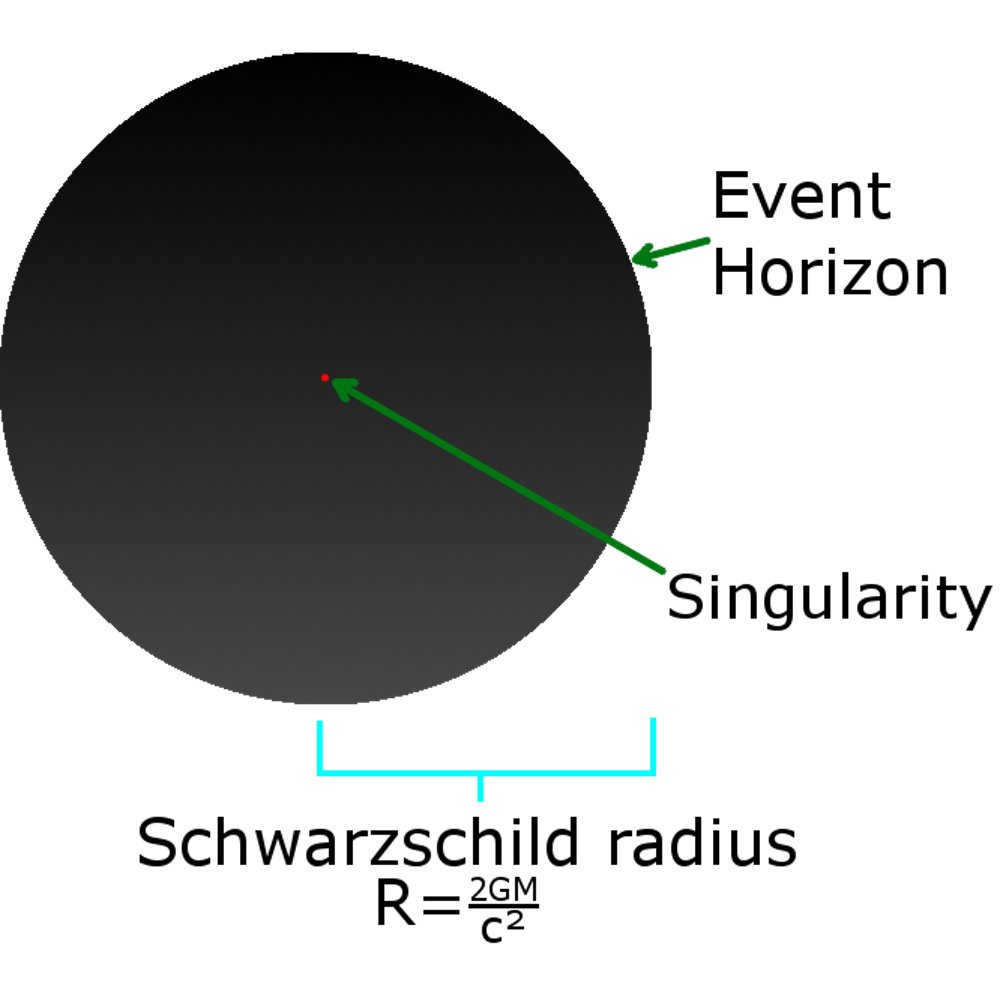
Basically, the reason why black holes are invisible is because light cannot escape from them. It appears that in order for an object to escape from a black hole, it would need to travel faster than the speed of light, which is approximately 299,792,458 meters per second. To put things into perspective, the escape velocity needed to overcome the Earth’s gravitational pull is only 11.2 kilometers per second. However, if we were to launch a rocket from a planet with the same mass as Earth but with half the diameter, the escape velocity would increase to 15.8 kilometers per second. Even if the object had the same mass, the escape velocity would be higher due to its smaller size and greater density.
What if we were to reduce the size of the object even further? If we were to condense the mass of the Earth into a sphere with a diameter of just nine millimeters, the velocity required to escape its gravitational pull would equal that of light. If we were to compress that mass into an even tinier sphere, the escape velocity would exceed the speed of light. However, given that the speed of light is the ultimate speed limit in the cosmos, nothing would be able to escape from this sphere.
The radius at which the mass possesses an escape velocity equal to the speed of light is known as the Schwarzschild radius. Any entity that is smaller than its Schwarzschild radius would be classified as a black hole. In other words, any object with an escape velocity greater than that of light would be considered a black hole. To transform the Sun into such an entity, it would need to be compressed to a radius of roughly three kilometers.
A black hole is composed of two primary components: the singularity and the event horizon. The magnitude of a black hole’s event horizon is regarded as the magnitude of the black hole as it can be computed and quantified.
The horizon is also known as the “point of no return” in the vicinity of a black hole. It is not a tangible surface, but rather a spherical boundary encircling the singularity, delineating a threshold where the escape velocity is equivalent to the speed of light. The radius of this area is referred to as the Schwarzschild radius.
Once matter crosses the event horizon, it immediately starts moving towards the core of the black hole. The immense gravitational force causes the matter to become compressed into an infinitesimally small point, creating a singularity of mind-boggling density. According to our current theoretical models, this singularity possesses infinite density and is essentially negligible in size. It is conceivable that the laws of physics as we currently understand them break down within the singularity. Scientists are actively researching this phenomenon in order to grasp the nature of singularities and to formulate a comprehensive theory that explains the dynamics of the black hole’s core. Let’s perform some calculations.
The proportion of the Earth to the Sun is 3 parts in a million. Therefore, if the Earth were to transform into a black hole, its size would shrink to a mere 9 millimeters. Consequently, a black hole with a diameter of 1 millimeter would possess a mass equivalent to 11% of the Earth’s mass. This additional mass would undoubtedly pose a problem for our planet.
It is significant enough that the Earth’s gravitational pull would experience a noticeable increase. This augmented gravity would be sufficient to alter the Moon’s trajectory, possibly causing it to deviate from its current path and adopt an elliptical orbit.
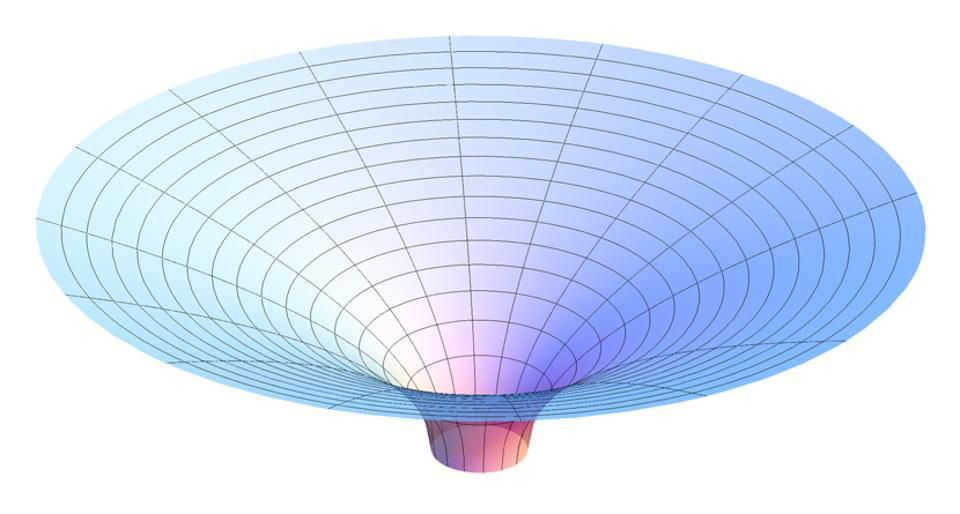
Where is this hypothetical black hole situated – on the surface, at the core of the Earth, or encircling it? Let’s assume it is positioned on the planet’s surface. The region within which its gravitational pull is felt would be roughly one-third of the Earth’s radius, equivalent to approximately 2124 kilometers.
All objects in the immediate vicinity of this minuscule black hole would instantaneously experience its powerful gravitational force, and in turn, the black hole would absorb anything in its path as it journeys towards the Earth’s core, a trip that would take approximately 42 minutes from its initial appearance. It would traverse through the Earth’s core and emerge on the other side of the planet’s surface in roughly the same timeframe.
If the black hole had emerged on the surface with a velocity lower than 12 km/s, it would revolve around the Blue Planet, dragging its gravitational field with it. To put it differently, it would annihilate the Earth’s crust and the majority of its mantle. To put it in the simplest terms, it would result in the extinction of all life on the Earth’s surface.
The Accretion Process and the Eddington Limit
The vast majority of the Earth’s mass surrounding the black hole will serve as sustenance and be absorbed by it. However, prior to being able to simply plunge into the black hole, all of this matter must shed its angular momentum, thus causing it to begin revolving around the black hole and forming an accretion disk.
As this matter interacts with the black hole, it generates a significant amount of heat, which will eventually be emitted as radiation. This radiation exerts a pressure that serves to slow down the process of further accretion. The combined effects of heat production and radiation pressure reach a delicate equilibrium, commonly referred to as the Eddington limit.
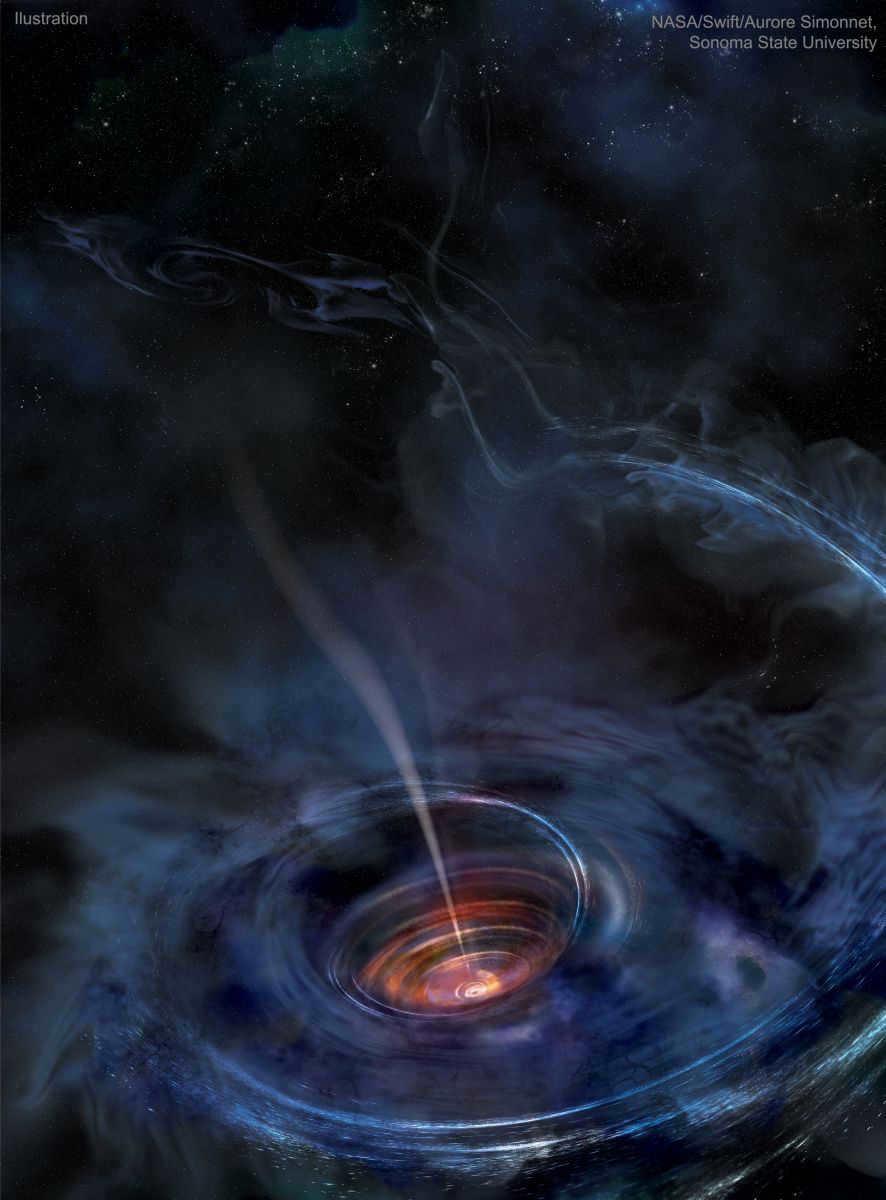
The Eddington limit sets a strict boundary on the level of accretion that a black hole can experience. A compact accretion disk is expected to have a temperature of approximately six thousand Kelvin, which is comparable to the Earth’s core or the surface of the Sun.
As a result of frictional interactions between the accretion disk and the Earth’s mass, it is possible for a minuscule black hole to become embedded within the planet’s core.
Demise in a black hole
It would require approximately five billion years for such a black hole to engulf the Earth entirely. This process would result in a significant increase in the Earth’s mass. Additionally, it would create absolute chaos on the planet, transforming it into an uninhabitable celestial remnant of collapsing crust, molten lava, scorching gases, and more, within just a few hours.
Survival would become an impossibility, and the immense mass of the black hole might also obliterate the asteroid belt. Consequently, this could lead to frequent collisions within the solar system for the next million years. Despite these cataclysmic events, the Moon would persist in orbiting around the newly formed celestial body (the black hole) but in an extremely elongated elliptical trajectory.
The black hole will not immediately move to the Earth’s center, but it will instead orbit around it for a period of time before eventually reaching it. In order to comprehend how this tiny black hole gains mass, complex calculations and simulations are required.
All of this information can be summarized by the renowned astrophysicist and popular science communicator Neil Degrasse Tyson, who once said, “The most spectacular demise in the universe is undoubtedly falling into a black hole. Where else can you lose your life by being torn apart at the atomic level?”
In a galaxy located 4.2 billion light-years away from Earth, two neighboring black holes emit curvy jets, while a third black hole slightly further away emits straight jets. This research indicates that this type of system is more prevalent than previously believed.
Researchers have made an incredible finding: a distant galaxy containing not just one, but three supermassive black holes in its core. This groundbreaking discovery suggests that clusters of these enormous black holes are far more prevalent than previously imagined, potentially providing a new method for their detection.
Supermassive black holes, which possess a mass equal to that of millions or even billions of suns, are thought to exist at the center of nearly every large galaxy in the known universe. While most galaxies have a solitary supermassive black hole at their core, the process of galactic merging can result in the formation of multiple black holes within a single galaxy.
A group of scientists has made an intriguing observation of a distant galaxy named SDSS J150243.09+111557.3. Initially, they suspected the presence of two massive black holes within it. This galaxy is located approximately 4.2 billion light-years away from our planet, which is roughly one-third of the distance across the universe, as stated by Roger Deane, the lead author of the study and a radio astronomer at the University of Cape Town in South Africa. To investigate this galaxy further, the researchers employed a technique called ultra-long-baseline radio interferometry (ELBI) by combining signals from various large radio antennas separated by distances of up to 10,000 kilometers. Remarkably, the European VLBI network allowed them to observe details that were 50 times more precise than what the Hubble Space Telescope could capture.
Unexpectedly, the astronomers stumbled upon an astonishing revelation – instead of two giant black holes, the galaxy actually harbors three of them simultaneously. Interestingly, two of these black holes are positioned in such close proximity to each other that they give the impression of being a single entity.
Each of the three black holes possesses a mass equivalent to approximately 100 million suns.
Prior to this discovery, scientists were aware of four triple black hole systems. However, the closest pair of objects in this new trio is separated by approximately 7,825 light-years. In comparison, the minimum distance between the two black holes in this trio is only about 455 light-years, making it the second closest pair of black holes.
After examining just six galaxies, the researchers stumbled upon this pair of black holes. This finding implies that dense pairs of supermassive black holes are “significantly more prevalent than previously believed.” The researchers emphasized that comprehending the frequency at which supermassive black holes merge can enhance our understanding of their impact on galaxies.
Black holes of enormous size have the ability to contribute to the development of galaxies by releasing bursts of energy from turbulent matter that gets consumed by the black hole. Although it has been challenging in the past to distinguish between closely paired supermassive black holes, scientists have discovered that the newest pair leaves behind a distinctive trail of radio waves that resembles a spiral. This implies that these twisted jets could serve as a distinctive characteristic of closely paired black holes. If this is indeed the case, there may be no need to rely on high-resolution telescopic observations such as the European RSDB network.
Roger Deane, a radio astronomer from the University of Cape Town in South Africa, added that the spiral radio jets found in closely paired black holes could be an efficient method for identifying these systems that are even more closely intertwined.
Roger Deane, a radio astronomer from the University of Cape Town in South Africa, is currently studying the fascinating phenomenon of two separate black holes from interacting galaxies slowly coming together, impacting their respective galaxies, emitting gravitational waves, and eventually merging into one. This process, which is predicted to be a truly awe-inspiring event, is a major mystery in the fields of cosmology and stellar evolution.
One of the key questions that Deane and his colleagues are trying to answer is how these supermassive black holes in the early universe became so massive. It is believed that they did not have enough time to accumulate their mass solely through sustained accretion processes. Therefore, understanding the mechanisms behind their rapid growth is essential in order to achieve a self-consistent understanding of the universe.
Two newborn black holes emerged from the demise of a solitary supergiant star. Artistic portrayal.
Initially, one must consume an amount of matter equivalent to a billion suns, even with a voracious appetite and a formidable gravitational pull it requires more than a couple of centuries. Yet, there they exist, these colossal black holes, originating in remote galaxies, where they already boasted their grandeur when the Universe marked its millionth birthday.
Recent investigations conducted at the California Institute of Technology have revealed that these immense black holes were birthed from the demise of specific kinds of originally colossal stars, extraordinary stellar behemoths that perished prematurely. During their cataclysmic collapse, not one but two black holes are generated simultaneously, each accumulating its own mass, subsequently merging into one mammoth supermassive entity.
In order to comprehend the source of youthful supermassive black holes, Christian Reisswig, a postdoctoral fellow in astrophysics at the California Institute of Technology, and Christian Ott, an assistant professor of theoretical astrophysics, investigated a model utilizing supermassive stars. These colossal, relatively uncommon stars are believed to have existed for a brief period in the early universe.
Dissimilar to typical stars, supermassive stars stabilize themselves in opposition to gravity, predominantly through their own emission of photons.
Within an exceedingly massive star, the emission of photons (the outward-facing flow of photons resulting from the exceedingly high internal temperatures of the star) propels the gas away from the star, while the force of gravity, conversely, pulls it inward.
Previous investigations have revealed that when supermassive stars collapse, they assume a spherical form that becomes distorted as a result of rapid rotation. This particular configuration is referred to as an axisymmetric shape.
Taking into consideration the notion that stars rotating at high speeds tend to exhibit minimal fluctuations, Reisswig and his colleagues hypothesized that these fluctuations may have caused the star to deviate from an axisymmetric shape during its demise. The small oscillations started to amplify rapidly, ultimately leading to the formation of high-density fragments in the star’s gas.
Christian Reisswig, a postdoctoral fellow at the California Institute of Technology
It appears highly likely that black holes could have grown to supermassive proportions in the early universe if the initial “seed” had a sufficiently large mass.
Photographs from Chandra and Hubble showcasing supermassive black holes in the early universe.
These pieces circled around the core of the star and grew more compact and hotter as they accumulated matter.
Then, an “exceptionally intriguing” event occurs.
When the temperatures reach a certain level, energy is generated that enables the creation of electron-positron pairs by electrons and their antiparticles, positrons. The formation of these pairs results in a decrease in pressure, speeding up the disintegration process. Consequently, the two revolving fragments become incredibly dense and form two black holes. Furthermore, as they continue to expand, they merge into a single massive black hole.
A black hole is like a one-way ticket. In accordance with the general theory of relativity, anything that passes through its boundary, known as the event horizon, will never return. For particles, entering a black hole means venturing into the future without any hope of coming back. We will forever remain ignorant of what transpires within the black hole’s vortex. The light emitted by the particle (which is our only means of observing its final moments) will gradually stretch out, becoming fainter and fainter until it vanishes entirely.
Indeed, the tale is far more peculiar. Should we observe the descent of the particle, there is a chance we may never witness its crossing of the event horizon. The immense gravitational pull of a black hole distorts time, causing it to pass much more slowly for an external observer in close proximity. To us, it would appear as though the particle is gradually approaching the event horizon for an eternity. However, from the particle’s perspective, this transition would occur invisibly, without any anomalous occurrences in the fabric of spacetime.
If a black hole serves as a gateway to an abyss, it naturally begs the question: is there an escape route?
Essentially, a white hole can be thought of as the reverse of a black hole. The overall theory is quite capable of predicting and mathematically describing such entities.
However, the question remains: do white holes actually exist? And if they do, what does that imply about the time symmetry?
Existence and Significance
Black holes are abundant in the universe, with nearly every major galaxy containing a massive void at its core, not to mention the smaller ones. Yet, scientists have yet to observe a single white hole. Nevertheless, this lack of detection does not necessarily prove their absence; it could simply mean that we have yet to find them. If white holes do repel particles, there is a chance that they remain invisible to our current methods of observation.
There is an unknown process through which supermassive black holes, which weigh millions or billions of times more, are created. Regardless, they also form due to a gravitational collapse, whether it be from a massive star that emerged during the early stages of the universe, a massive gas cloud within a primordial galaxy, or some other occurrence.
A question of time
So, we have established that there are numerous black holes scattered throughout our Universe, yet there are no white holes to be found. However, this does not imply that time is asymmetrical. The general theory of relativity still holds true, but the phenomenon of gravitational collapse dictates that time only flows in one direction. This aligns with the overall state of the cosmos.
At some point in the distant past, the Big Bang occurred, resulting in a rapid expansion that seemingly originated from a singular point. Simultaneously, all evidence suggests that the Big Contraction, the hypothetical convergence of all matter into a single point in the distant future, is highly unlikely. If current patterns persist (assuming dark energy does not undergo drastic changes), the Universe will continue to expand at an accelerating rate. In this scenario, the universe clearly lacks symmetry.
Actually, we have already had an extensive discussion about . Here is one more. . Here is the original article on the website InfoGaze.rf. The link to the article from which this duplicate was generated is –
That is the reason why it becomes challenging to anticipate the outcome of the merging of black holes (which is essentially the same as the creation of a new one).
However, there are cataclysmic incidents that are known as gamma-ray bursts, and their precise nature is yet to be determined. These bursts are observed as brief bursts of gamma radiation, lasting roughly a minute, originating from a location in deep space that is even farther than the local super cluster of galaxies. Furthermore, the total energy released during these events is exceedingly high. They are often referred to as neutron star mergers, but they could also involve the merging of black holes.
UPDATE. Exciting news, the confirmation of gravitational waves is finally here.
There could potentially be other objects that have not yet been predicted.
The interesting thing is that there are currently numerous extensions of GR that offer alternative solutions in extreme scenarios. For instance, there might be variations in the radius or the presence of a magnetic field. It is even possible to speculate about the existence of wormholes for travel between these objects. Alternatively, the concept of a black hole itself might be redefined. The possibilities are endless.
However, it is important to note that it is premature to declare the discovery of a Kerr or Schwarzschild black hole due to the limited amount of data available. Currently, we only have access to light curves from objects like Swan X-1 or trajectories of stars near the galactic center, but we have not yet directly observed a black hole.
Scientists at UCSC have proposed that the characteristics observed in active galactic nuclei (AGNs) can be attributed to dust clouds rather than double black holes. The findings were published in the Monthly Proceedings of the Royal Astronomical Society.
AGNs are found in many large galaxies and consist of a bright central region fueled by matter orbiting a supermassive black hole. When these black holes consume matter with high energy, they create a surrounding region of hot, fast-moving gas known as the “broad line region” (named after the broadening of spectral lines caused by the gas’s rapid movement).
The study was conducted by Martin Gaskell, a research associate in astronomy and astrophysics at UCSC. Rather than attributing the complexity and variability of broadband emissions to two black holes, Gaskell proposed that small dust clouds could be responsible for partially obstructing the deep regions of the AGN.
“By demonstrating the impact of these small dust clouds, we have provided an explanation for many of the enigmatic characteristics of active galactic nuclei,” Gaskell stated.
“According to Harrington, once the dust surpasses a particular threshold, it becomes subjected to intense radiation emitted by the accretion disk.”
Scientists hypothesize that this radiation is so powerful that it dislodges dust particles from the disk, leading to compulsive outflows of dust clouds that originate from the outermost edge of the broadband region.
The presence of these dust clouds has a significant impact on the light emitted, causing the light originating from behind them to appear dimmer and redder, much like how Earth’s atmosphere causes the Sun to appear smoother and redder during sunset. Gaskell and Harrington developed computer code to simulate the effects of these dust clouds in order to study the broadband region.
“According to Gaskell, we think that this explanation, which is more conventional, offers a more plausible reason for the asymmetries and fluctuations observed, compared to other unconventional theories like binary black holes that have been previously proposed by scientists. What sets our explanation apart is that it allows us to preserve the simplicity of the standard AGN model, where matter revolves around a lone black hole.”
like( 0 ) dislike( 0 )
As a result, pairs of black holes represent authentic celestial time bombs. The countdown of this explosive device relies on various factors, such as the dimensions and mass of the black holes, as well as the velocity and size of their original orbital paths. Once this countdown reaches zero, a tremendous gravitational detonation occurs, and the reverberations of this event ripple across the cosmos, alerting any beings capable of perceiving the “sound” of gravitational waves.
Formation of pairs of black holes can occur in a second way – when two black holes, which were formed separately in different parts of space, come together. This phenomenon is typically caused by the black hole losing its initial potential energy. This energy is used to accelerate nearby stars through a “gravitational slingshot” effect and attract matter from the surrounding space. Eventually, the black hole starts moving towards the center of a galaxy or a cluster of galaxies, where it encounters another black hole that is already present.
As double systems of black holes evolve, they gradually lose both kinetic and potential energy, causing them to come closer together. Consequently, this acceleration process speeds up over time, ultimately leading to an unavoidable collision. The convergence can be greatly expedited if one of the black hole companions receives an extra gravitational “kick” from a nearby star or cluster of matter in motion through space.
Currently, scientists are primarily focused on double black hole systems and the gravitational waves they produce. These systems can be thought of as cosmic “time capsules” that contain valuable information about the past. By decoding these gravitational explosions, scientists hope to uncover answers to fundamental mysteries of the Universe. It is only with the recent development of the LIGO gravitational observatory that mankind has gained the ability to study and analyze these phenomena.

Experts from the Tokyo Institute have recently stated that the supermassive black hole located at the core of a large galaxy could experience a loss of material as a result of a catastrophic collision between two galaxies. These astronomers have conducted extensive modeling to better understand the consequences of galaxy mergers. Further details regarding this groundbreaking study will be discussed by the scientists in the near future.
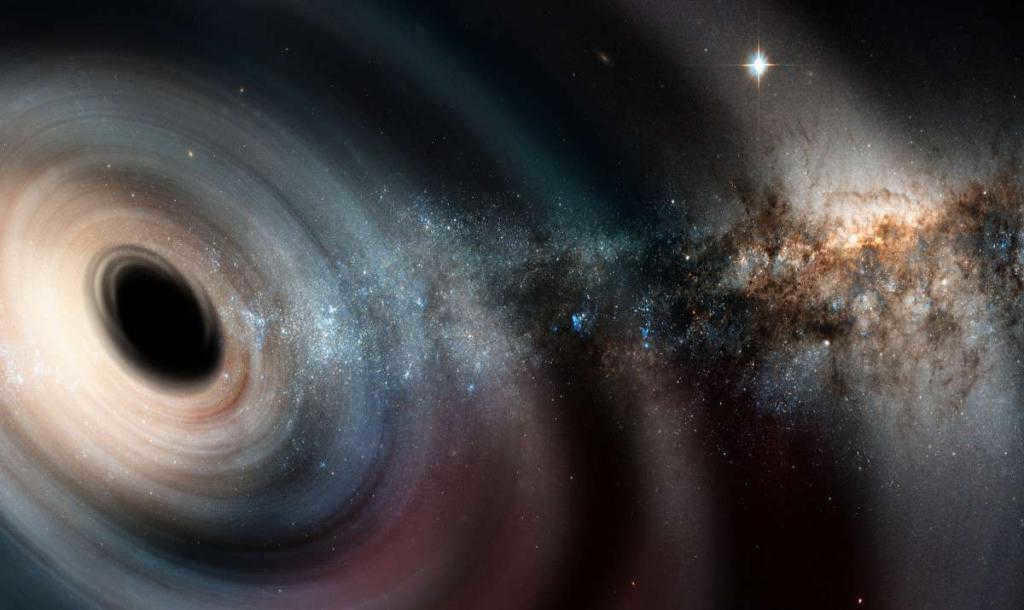
Previously, scientists had the belief that galactic collisions would inevitably lead to an increase in the activity of black massive holes (BMHs) located at their centers, as these holes would receive an additional supply of matter. However, a group of Japanese scientists has put forth the proposition that in certain “head-on collision” scenarios, the cores of galaxies could be stripped of the matter that typically fuels the activity of these black massive holes.
Astronomers who specialize in studying the composition of stars within the Milky Way have discovered evidence indicating that approximately 11 billion years ago, this galaxy experienced a significant collision with other galaxies on a large scale.
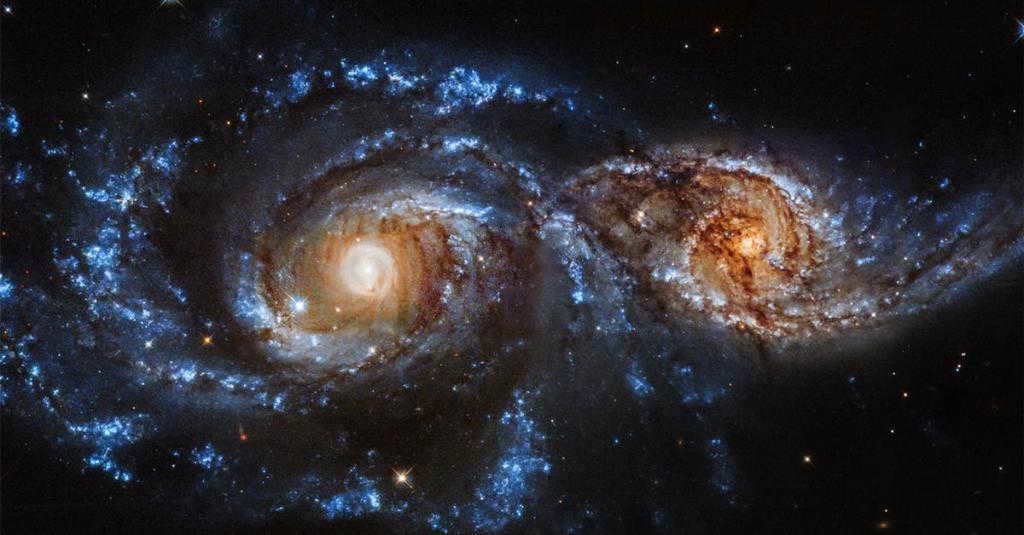
In the new study, researchers did not specifically model the Milky Way. However, senior author Yohei Miki explained that the black hole at the center of our galaxy, known as Sagittarius A*, is not as active as the black holes in other galaxies. This suggests that Sagittarius A* may have lost some of its material after colliding with another galaxy.
Study author Yohei Miki stated, “When people imagine a galactic collision, they often picture a massive cosmic event with stars falling and exploding. However, the reality is more like two clouds merging, with the smaller cloud being absorbed by the larger one.”
Collision of Galaxies
Galaxies undergo collisions in various manners – at times, a smaller galaxy collides with the outer region of a larger galaxy and either traverses it entirely or combines with it. In either scenario, a significant number of stars are exchanged during the process. Galaxies can also collide directly, resulting in the disintegration of the smaller galaxy due to the overpowering tidal forces exerted by the larger galaxy – this situation can leave the Cold Dark Matter (CDM) components devoid of the necessary material, causing them to become “starved”.
Study Overview
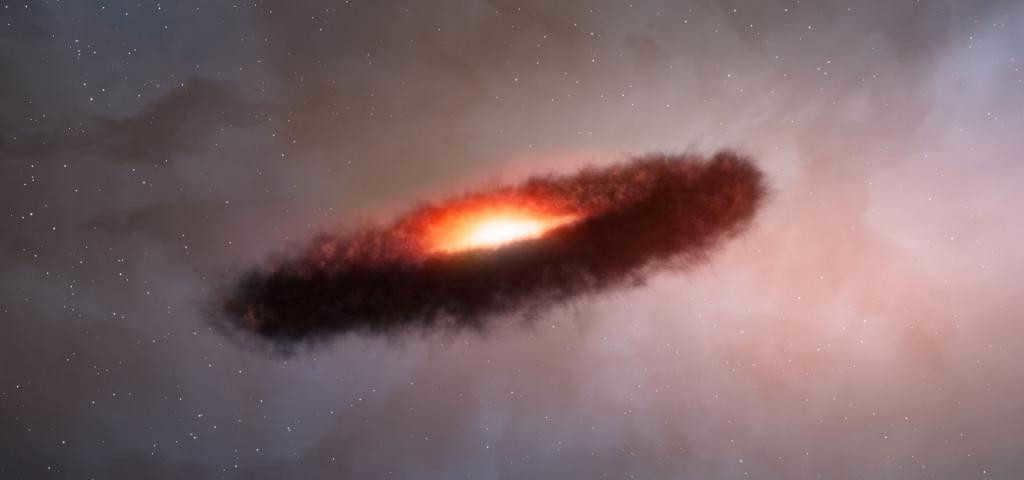
It appears to be a reasonable assumption that when galaxies collide in space, it would result in a higher level of CDM activity. However, Miki and his team were intrigued by this assertion and sought to substantiate it. They developed intricate simulations of galaxy collision scenarios and executed them on high-performance computers.
Objectives of the Study
The findings of the recent research could provide valuable insights into the evolutionary process of our Milky Way galaxy. Scientists strongly believe that our galaxy has encountered numerous smaller galaxies in the past. Furthermore, these findings may shed light on the potential outcome of the Milky Way’s collision with the larger spiral galaxy Andromeda in approximately 4.5 billion years.
Miki, in an interview with MailOnline, stated that future investigations will aim to determine the duration of any suppression of Cold Dark Matter (CDM). The results of this study have been published in the scientific journal Nature Astronomy.
The weight of the Sun is equivalent to one solar mass, which is equal to 2 x 10^30 kilograms. The mass of the entire galaxy is 1.5 trillion times greater than this, or 1.5 x 10^12 times the solar mass. Therefore, the Sun weighs approximately 3 x 10^42 kilograms, or 3 x 10^39 tons. In simpler terms, this means that the Milky Way weighs a staggering 3,000 trillion trillion tons.
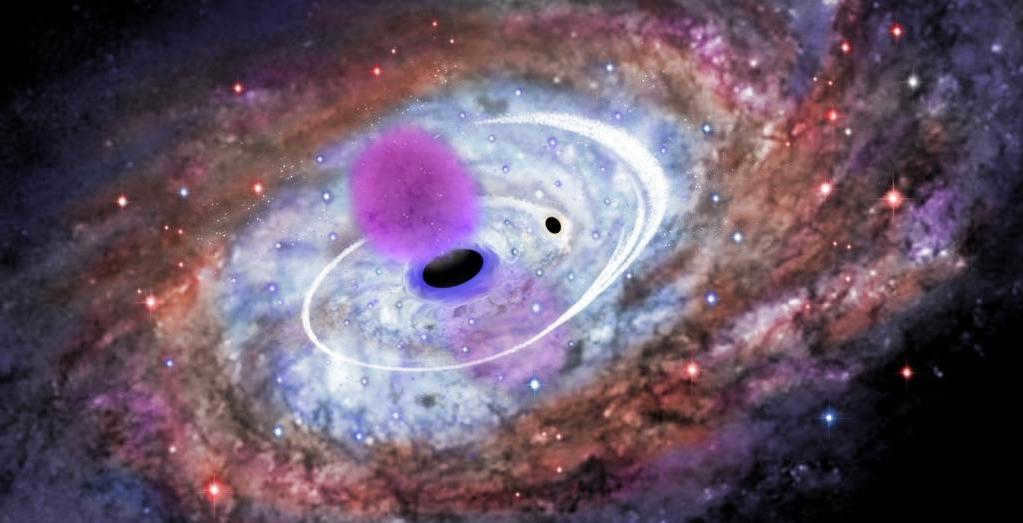
The dominant feature of the Milky Way galaxy’s center is a supermassive black hole called Sagittarius A* (Sgr A*). Supermassive black holes are extremely dense areas in the center of galaxies that can have a mass billions of times that of the Sun. They generate strong gravitational forces that attract and absorb surrounding dust and gas.
Evidence of a black hole at the center of our galaxy was first discovered by physicist Carl Jansky in 1931, when he detected radio waves coming from that region. Sgr A*, which is invisible but prominent, has a mass equivalent to four million suns. It is located just 26,000 light-years away from Earth, making it one of the few black holes in the Universe where we can directly observe the matter flowing around it.

